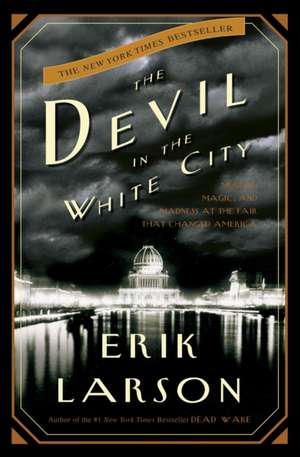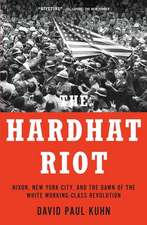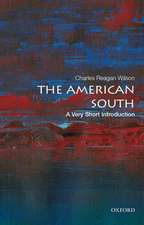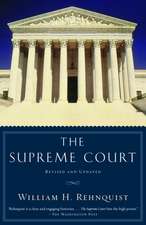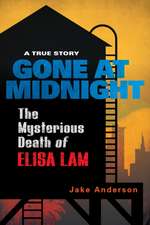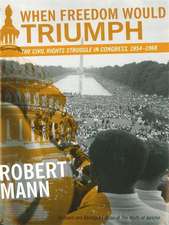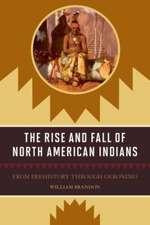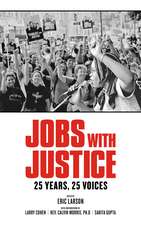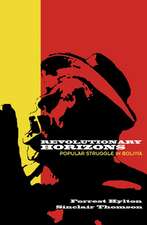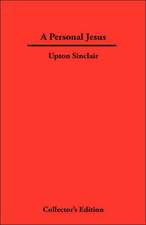The Devil in the White City
Autor Eric Larsonen Limba Engleză Hardback – 31 ian 2003
Vezi toate premiile Carte premiată
National Book Awards (2003), Edgar Allan Poe Awards (2004), Book Sense Book of the Year Award (2004)
The Devil in the White City draws the reader into a time of magic and majesty, made all the more appealing by a supporting cast of real-life characters, including Buffalo Bill, Theodore Dreiser, Susan B. Anthony, Thomas Edison, Archduke Francis Ferdinand, and others. In this book the smoke, romance, and mystery of the Gilded Age come alive as never before.
Erik Larson’s gifts as a storyteller are magnificently displayed in this rich narrative of the master builder, the killer, and the great fair that obsessed them both.
To find out more about this book, go to http://www.DevilInTheWhiteCity.com.
Preț: 197.11 lei
Nou
Puncte Express: 296
Preț estimativ în valută:
37.72€ • 39.38$ • 31.22£
37.72€ • 39.38$ • 31.22£
Carte disponibilă
Livrare economică 14-28 martie
Preluare comenzi: 021 569.72.76
Specificații
ISBN-13: 9780609608449
ISBN-10: 0609608444
Pagini: 464
Ilustrații: 1 MAP, 7 B&W PHOTOS
Dimensiuni: 164 x 242 x 36 mm
Greutate: 0.73 kg
Ediția:New.
Editura: Crown Publishing Group (NY)
Locul publicării:New York, NY
ISBN-10: 0609608444
Pagini: 464
Ilustrații: 1 MAP, 7 B&W PHOTOS
Dimensiuni: 164 x 242 x 36 mm
Greutate: 0.73 kg
Ediția:New.
Editura: Crown Publishing Group (NY)
Locul publicării:New York, NY
Notă biografică
Erik Larson is the author of six New York Times bestsellers, most recently The Splendid and the Vile: A Saga of Churchill, Family, and Defiance During the Blitz, which examines how Winston Churchill and his “Secret Circle” went about surviving the German air campaign of 1940-41. Larson’s The Devil in the White City is set to be a Hulu limited series; his In the Garden of Beasts is under option by Tom Hanks for a feature film. He recently published an audio-original ghost story, No One Goes Alone, which has been optioned by Chernin Entertainment, in association with Netflix. His Thunderstruck has been optioned by Sony Pictures Television for a limited TV series. Larson lives in Manhattan with his wife, who is a writer and retired neonatologist; they have three grown daughters.
Extras
The Black City
How easy it was to disappear:
A thousand trains a day entered or left Chicago. Many of these trains brought single young women who had never even seen a city but now hoped to make one of the biggest and toughest their home. Jane Addams, the urban reformer who founded Chicago's Hull House, wrote, "Never before in civilization have such numbers of young girls been suddenly released from the protection of the home and permitted to walk unattended upon the city streets and to work under alien roofs." The women sought work as typewriters, stenographers, seamstresses, and weavers. The men who hired them were for the most part moral citizens intent on efficiency and profit. But not always. On March 30, 1890, an officer of the First National Bank placed a warning in the help-wanted section of the Chicago Tribune, to inform female stenographers of "our growing conviction that no thoroughly honorable business-man who is this side of dotage ever advertises for a lady stenographer who is a blonde, is good-looking, is quite alone in the city, or will transmit her photograph. All such advertisements upon their face bear the marks of vulgarity, nor do we regard it safe for any lady to answer such unseemly utterances."
The women walked to work on streets that angled past bars, gambling houses, and bordellos. Vice thrived, with official indulgence. "The parlors and bedrooms in which honest folk lived were (as now) rather dull places," wrote Ben Hecht, late in his life, trying to explain this persistent trait of old Chicago. "It was pleasant, in a way, to know that outside their windows, the devil was still capering in a flare of brimstone." In an analogy that would prove all too apt, Max Weber likened the city to "a human being with his skin removed."
Anonymous death came early and often. Each of the thousand trains that entered and left the city did so at grade level. You could step from a curb and be killed by the Chicago Limited. Every day on average two people were destroyed at the city's rail crossings. Their injuries were grotesque. Pedestrians retrieved severed heads. There were other hazards. Streetcars fell from drawbridges. Horses bolted and dragged carriages into crowds. Fires took a dozen lives a day. In describing the fire dead, the term the newspapers most liked to use was "roasted." There was diphtheria, typhus, cholera, influenza. And there was murder. In the time of the fair the rate at which men and women killed each other rose sharply throughout the nation but especially in Chicago, where police found themselves without the manpower or expertise to manage the volume. In the first six months of 1892 the city experienced nearly eight hundred homicides. Four a day. Most were prosaic, arising from robbery, argument, or sexual jealousy. Men shot women, women shot men, and children shot each other by accident. But all this could be understood. Nothing like the Whitechapel killings had occurred. Jack the Ripper's five-murder spree in 1888 had defied explanation and captivated readers throughout America, who believed such a thing could not happen in their own hometowns.
But things were changing. Everywhere one looked the boundary between the moral and the wicked seemed to be degrading. Elizabeth Cady Stanton argued in favor of divorce. Clarence Darrow advocated free love. A young woman named Borden killed her parents.
And in Chicago a young handsome doctor stepped from a train, his surgical valise in hand. He entered a world of clamor, smoke, and steam, refulgent with the scents of murdered cattle and pigs. He found it to his liking.
The letters came later, from the Cigrands, Williamses, Smythes, and untold others, addressed to that strange gloomy castle at Sixty-third and Wallace, pleading for the whereabouts of daughters and daughters' children.
It was so easy to disappear, so easy to deny knowledge, so very easy in the smoke and din to mask that something dark had taken root.
This was Chicago, on the eve of the greatest fair in history.
How easy it was to disappear:
A thousand trains a day entered or left Chicago. Many of these trains brought single young women who had never even seen a city but now hoped to make one of the biggest and toughest their home. Jane Addams, the urban reformer who founded Chicago's Hull House, wrote, "Never before in civilization have such numbers of young girls been suddenly released from the protection of the home and permitted to walk unattended upon the city streets and to work under alien roofs." The women sought work as typewriters, stenographers, seamstresses, and weavers. The men who hired them were for the most part moral citizens intent on efficiency and profit. But not always. On March 30, 1890, an officer of the First National Bank placed a warning in the help-wanted section of the Chicago Tribune, to inform female stenographers of "our growing conviction that no thoroughly honorable business-man who is this side of dotage ever advertises for a lady stenographer who is a blonde, is good-looking, is quite alone in the city, or will transmit her photograph. All such advertisements upon their face bear the marks of vulgarity, nor do we regard it safe for any lady to answer such unseemly utterances."
The women walked to work on streets that angled past bars, gambling houses, and bordellos. Vice thrived, with official indulgence. "The parlors and bedrooms in which honest folk lived were (as now) rather dull places," wrote Ben Hecht, late in his life, trying to explain this persistent trait of old Chicago. "It was pleasant, in a way, to know that outside their windows, the devil was still capering in a flare of brimstone." In an analogy that would prove all too apt, Max Weber likened the city to "a human being with his skin removed."
Anonymous death came early and often. Each of the thousand trains that entered and left the city did so at grade level. You could step from a curb and be killed by the Chicago Limited. Every day on average two people were destroyed at the city's rail crossings. Their injuries were grotesque. Pedestrians retrieved severed heads. There were other hazards. Streetcars fell from drawbridges. Horses bolted and dragged carriages into crowds. Fires took a dozen lives a day. In describing the fire dead, the term the newspapers most liked to use was "roasted." There was diphtheria, typhus, cholera, influenza. And there was murder. In the time of the fair the rate at which men and women killed each other rose sharply throughout the nation but especially in Chicago, where police found themselves without the manpower or expertise to manage the volume. In the first six months of 1892 the city experienced nearly eight hundred homicides. Four a day. Most were prosaic, arising from robbery, argument, or sexual jealousy. Men shot women, women shot men, and children shot each other by accident. But all this could be understood. Nothing like the Whitechapel killings had occurred. Jack the Ripper's five-murder spree in 1888 had defied explanation and captivated readers throughout America, who believed such a thing could not happen in their own hometowns.
But things were changing. Everywhere one looked the boundary between the moral and the wicked seemed to be degrading. Elizabeth Cady Stanton argued in favor of divorce. Clarence Darrow advocated free love. A young woman named Borden killed her parents.
And in Chicago a young handsome doctor stepped from a train, his surgical valise in hand. He entered a world of clamor, smoke, and steam, refulgent with the scents of murdered cattle and pigs. He found it to his liking.
The letters came later, from the Cigrands, Williamses, Smythes, and untold others, addressed to that strange gloomy castle at Sixty-third and Wallace, pleading for the whereabouts of daughters and daughters' children.
It was so easy to disappear, so easy to deny knowledge, so very easy in the smoke and din to mask that something dark had taken root.
This was Chicago, on the eve of the greatest fair in history.
Descriere
In a thrilling narrative showcasing his gifts as storyteller and researcher, Larson recounts the spellbinding tale of the 1893 World's Columbian Exposition and its devious creators. A blend of "Ragtime" and "Silence of the Lambs, The Devil in the White City" is Larson at his best. 6 photos. 1 map.
Premii
- National Book Awards Finalist, 2003
- Edgar Allan Poe Awards Winner, 2004
- Book Sense Book of the Year Award Nominee, 2004
- Pacific Northwest Booksellers Association Award Winner, 2004
- Eliot Rosewater Indiana High School Book Award Nominee, 2006
- Washington State Book Award Winner, 2004
